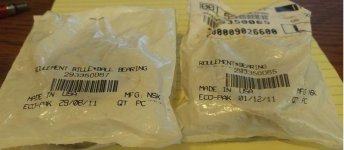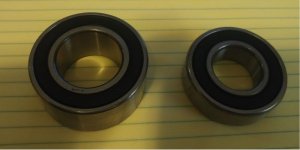h0gr1der
New member
During my tire replacement follies, I discovered that my rear rim and wheel bearings are also Chinese. Can't do much about the rim, but I can source American bearings.
Everyone throws around the 6205-2RS single row and the 30BD40DF2 double row bearings. I ordered both, but they don't match in size.
I bought SKF Explorer 6205-2RS single row bearings. They are 25 I.D. x 52 O.D x 15W mm.
The other NSK 30BD40DF2 double row is 30 I.D. x 55 O.D. x 23W mm.
Looking up the 6205-2RS specs at bearing jobbers, it seems the 25x52x15 are standard dimensions.
Did the axle change? Wrong part numbers? Why 2 different I.D. and O.D.? I want to make sure I have the right parts on hand for when I pull it down. Any help would be much appreciated.
Everyone throws around the 6205-2RS single row and the 30BD40DF2 double row bearings. I ordered both, but they don't match in size.
I bought SKF Explorer 6205-2RS single row bearings. They are 25 I.D. x 52 O.D x 15W mm.
The other NSK 30BD40DF2 double row is 30 I.D. x 55 O.D. x 23W mm.
Looking up the 6205-2RS specs at bearing jobbers, it seems the 25x52x15 are standard dimensions.
Did the axle change? Wrong part numbers? Why 2 different I.D. and O.D.? I want to make sure I have the right parts on hand for when I pull it down. Any help would be much appreciated.
Driven pulley takes a 30BD40DF2 (double row) Also Known As: 30BG05S5G2DS 30x55x23mm.
Wheel takes 2 of 6205 2RS bearings. Seals are 37x55mm two needed but will need OEM as they're an odd size
Three O-rings 15IDx3mm needed and one 60IDx3mm
The O rings and seals are cheap so replace all. Allow a couple of hours, no need to rush. Circlip pliers needed and usual hand tools. The OEM pulley bearing doesn't seem to last terribly long - usually the first of the 3 to go and indicated by belt track moving and/or click/rattle (but this can be caused by other things too.)


